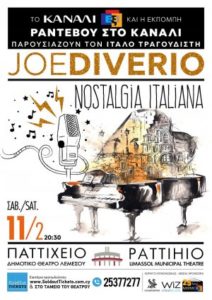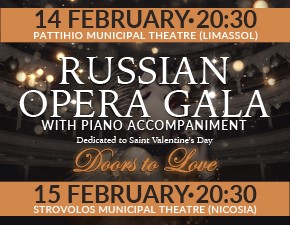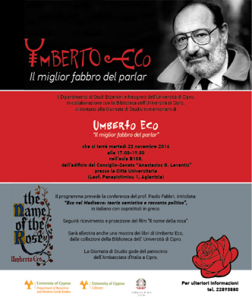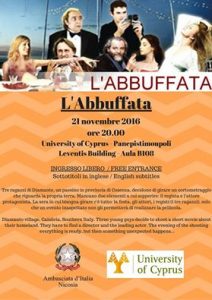It’s pasta time in Limassol!
For all pasta lovers this Friday in Limassol at “Da Franco”!
Italiancyprus will be there 🙂 Join us!
A lot of beautiful Italian music this February in Limassol !
February is the month of romantic Italian music, don’t you thinks so?
Some of the musical happenings this February in Limassol are:
Joe Diverio “Nostalgia Italiana” and
Doors to Love – Russian Opera Gala with piano
No need to ask, Italian Cyprus will be there with students 🙂
Can foreigners learn to gesticulate like Italians ?
Ricerca: stranieri possono imparare a gesticolare come italiani?
Gli stranieri che raggiungono un alto livello di competenza in lingua italiana sono anche in grado di pensare in italiano e, conseguentemente, di utilizzare la nostra ben nota gestualità. Sono queste le conclusioni di uno studio condotto da un ricercatore danese che ha testato la capacità di alcuni studenti di lingua italiana suoi connazionali di apprendere a gesticolare come gli italiani.
Secondo quanto riferisce il portale locale CPH Post Online, il ricercatore Bjørn Wessel-Tolvig ha verificato come gli studenti di lingua straniera con un alto livello di competenza siano in grado di modificare i propri modelli cognitivi nel parlare una lingua diversa da quella materna. Nel caso dello studio dell’italiano poi tale cambiamento a livello cognitivo sarebbe particolarmente visibile, a detta di Wessel-Tolvig, soprattutto a livello gestuale. Secondo lo studioso, inoltre, gli italiani produrrebbero nel parlato circa il doppio dei gesti eseguiti dai danesi.
Wessel-Tolvig spera che la sua ricerca possa aumentare la consapevolezza del fatto che la lingua è multidimensionale e che gli studenti non siano giudicati in futuro solo in base alle loro competenze puramente verbali e grammaticali.
Per leggere l’articolo clicca: stranieri possono imparare a gesticolare come italiani?
È nato prima il panettone o il pandoro?
 Senza dubbio il panettone. La ricetta del tipico dolce natalizio, infatti, iniziò a circolare già nel XVI secolo. Il primo a scrivere di una focaccia dolce che ricorda l’impasto del panettone fu Cristoforo di Messisbugo, un cuoco di Ferrara che nel 1549 in un suo ricettario parlava di un dolce fatto dalle parti di Milano, a base di farina, burro, zucchero uova e latte. Non c’erano ancora uvette e canditi, ma l’impasto era lo stesso.
Senza dubbio il panettone. La ricetta del tipico dolce natalizio, infatti, iniziò a circolare già nel XVI secolo. Il primo a scrivere di una focaccia dolce che ricorda l’impasto del panettone fu Cristoforo di Messisbugo, un cuoco di Ferrara che nel 1549 in un suo ricettario parlava di un dolce fatto dalle parti di Milano, a base di farina, burro, zucchero uova e latte. Non c’erano ancora uvette e canditi, ma l’impasto era lo stesso.
 PANE D’ORO. La storia del pandoro è invece molto più recente. Nasce dall’intuito del veronese Domenico Melegatti, nel 1894, a Verona. Lo chiamò “pane d’oro” forse in omaggio agli antichi pani d’oro della Repubblica di Venezia, un modo per ricordare l’abitudine delle antiche famiglie veneziane di impreziosire i propri pani con foglie dorate.
PANE D’ORO. La storia del pandoro è invece molto più recente. Nasce dall’intuito del veronese Domenico Melegatti, nel 1894, a Verona. Lo chiamò “pane d’oro” forse in omaggio agli antichi pani d’oro della Repubblica di Venezia, un modo per ricordare l’abitudine delle antiche famiglie veneziane di impreziosire i propri pani con foglie dorate.
Il vero antenato è però probabilmente il Nadalin, un dolce veneto casalingo a forma di stella.
The First Week of Italian Cuisine in the World
Many lovely happenings for all foodies
Majority in Nicosia, but here is the whole program of the The First Week of Italian Cuisine in the World !
Italiancyprus will be there 🙂
Conference in memoriam of Umberto Eco, “Il miglior fabbro del parlar”.
Conference in memoriam of Umberto Eco, “Il miglior fabbro del parlar”.
The Embassy of Italy has the pleasure to invite you to the day conference in memoriam of Umberto Eco which will take place on Tuesday 22 November from 17.30 to 19.00 at the “Anastasios G. Leventis” Building, classroom B106 in the University Campus (Panepistimiou Avenue 1, Aglantzia). The event, organized by the Department of Byzantine and Modern Greek Studies, under the auspices of the Embassy of Italy in Cyprus, will feature the conference of Prof. Paolo Fabbri headed “Medieval Umberto Eco: semiotic theory and political story” in Italian with supertitles in Greek. A reception and the screening of the film “The Name of the Rose” will follow. For further information please see the detailed program (in Italian and in Greek).
In the framework of the First Week of the Italian Cuisine in the World
The Embassy of Italy invites you to the screening of the Italian film “L’Abbuffata”, on the 21th of November at 20.00 at the University of Cyprus. The event is organized in the framework of the First Week of the Italian Cuisine in the World. In Italian language with English subtitles. Entrance is free.
Many Italian happenings in Cyprus next week!
Did you know that this November there is a celebration of the First Week of Italian Cuisine in the World ?
Italian Embassy is preparing some surprises for us!
First Week of Italian Cuisine in the World (21st to 27th November 2016)
A week of fine Italian food and dining in Cyprus (and all over the world)
Cyprus will be among the over 100 countries where, from the 21st to the 27th of November 2016, the 1st Week of Italian Cuisine in the World will be celebrated: an initiative of the Italian Government to promote the excellence of Italian wines and food abroad which will feature 1.300 events in every continent under the title The Extraordinary Italian Taste.
The Italian Embassy in Nicosia has called upon restaurants and organizations who are particularly committed to Italian fine dining – with a high quality standard and a rigorous selection of ingredients – to organize special gastronomic and educational events about the Italian culinary tradition.
A particularly rich program is being organized by Isolani Pizza Bar in Nicosia, which features an evening of Umbrian delicacies entitled “Osteria Italia” (Monday 21st) and a “Sardinian Deluxe Sunday Lunch” (Sunday 27th) with the award-winning Sardinian Chef Franco Podda from the Restaurant “Santa Rughe” in Gavoi (Nuoro), who will bring special ingredients directly from his hometown (Mr Podda will also hold a masterclass for students at the C’ Technical School of Limassol). Tickets to both gastronomic events can be purchased directly at the Italian Embassy.
Milestones of Italian Neorealism, Italian movies in Nicosia
The Embassy of Italy is pleased to invite you to a series of screenings of some of the most important movies in the history of Italian neorealist cinema: Rome, Open City and Paisà by Roberto Rossellini, The Earth Trembles (La Terra trema) by Luchino Visconti and Bicycle Thieves by Vittorio de Sica. The event is organized along with “The Friends of Cinema Society” and will take place at the University of Nicosia (Cine Studio). Entrance is free.
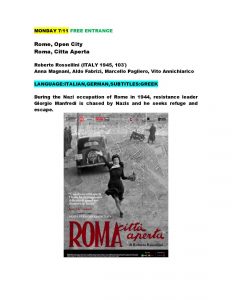
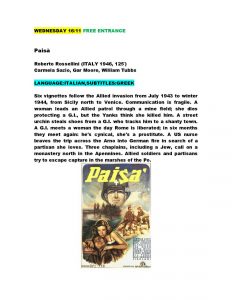
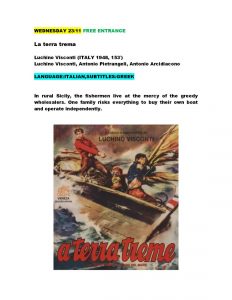

“The creative use of Italian in trademarks, advertising slogans and shop signs” – Conference by Prof. Joseph Brincat
Something different and very interesting and Italian Cyprus will be there!
The Embassy of Italy kindly invites you to the lecture “The creative use of Italian in trademarks, advertising slogans and shop signs” of Prof. Joseph Brincat (University of Malta) in the framework of the 16th week of the Italian language worldwide. The conference, organized by the Embassy of Italy in Nicosia with the support of the Embassy of Switzerland, will be held on Thursday 20 October, 20.30, at the Cultural Centre of the University of Cyprus, Manor House on Axiotheas Street, Old Nicosia.
For further information please visit the Embassy of Italy in Nicosia website:http://

